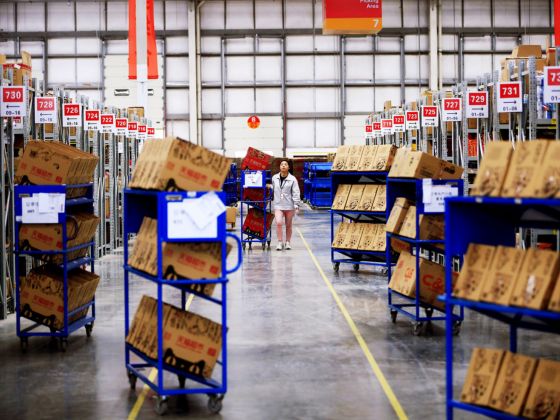China’s e-commerce gold rush is on, and deliverymen dig in

An employee at a Tmall (formerly Taobao Mall) logistic centre in Suzhou, Jiangsu province. Tmall is operated by Alibaba in China. Photo: Reuters
Worth S$3 trillion a year, local logistics sector lacks glamour but makes up for it in sheer heft.
HONG KONG — Couriers and hulking warehouses are to China’s US$600 billion (S$852 billion) e-commerce sector what shovels were to the gold rush: The crucial element of a rapidly growing industry.
What China’s logistics sector lacks in glamour it makes up for in sheer heft. The mainland industry is worth some US$2.2 trillion, out of US$9 trillion globally, according to logistics consultancy Armstrong & Associates.
Of that, express — effectively e-commerce delivery — accounted for US$43.5 billion last year and is the fastest-growing segment, expanding at a compound annual rate of more than 30 per cent.
These numbers have piqued investors’ interest, while cheap deliveries have wowed shoppers.
“To some degree Chinese consumers are spoiled,” said Mr Duncan Clark, chairman of consultancy BDA. “Because of the low-cost delivery options, the balance has shifted much more towards the consumer in China than it has in the US or Europe.”
The average 13 yuan (S$2.68) delivery fee, against US$5-US$10 in the US, means shoppers have no qualms about buying half-a-dozen jumpers and sending back five, he said. Meanwhile, the couriers who shuttle parcels around the towns and cities can often be spotted sorting their parcels kerbside, bikes askew.
But such scenes are being erased by the logistics industry.
“It is still changing very fast,” said Mr John Song, who leads Deloitte China’s logistics and transportation practice. “At least some of them call themselves tech companies, which means they invest big amounts of money in IT systems, big data, automation and also the last-mile delivery, using, say, drone deliveries and driverless vehicles.”
Spearheading that drive is Cainiao, the tech-driven logistics network in which e-commerce giant Alibaba holds a 47 per cent stake.
Rather than an empire of warehouses and fulfilment centres like Amazon or local rival JD.com, Cainiao has assembled a network of 15-16 of the biggest delivery companies and built a data platform that enables speedier and more efficient service by letting couriers bundle deliveries in the same area.
Standardised addresses and mapping allow them to more easily find their destination, and Cainiao now processes seven of every 10 packages delivered daily in China.
Mr Clark said that Cainiao was born out of the same frustration with an inefficient national post office that prompted Wells Fargo to launch its own private parcel delivery and banking during the California gold rush in the mid-19th century.
Mr Wang Wenbin, chief technology officer at Cainiao, said that even with improved IT systems, Chinese couriers are still lagging behind the likes of UPS and FedEx in the US. However, by starting later, China is able to leapfrog transitional changes.
China’s market is more labour intensive, he said, and has other obstacles: Inaccurate post codes, for example, and in the rapidly growing cities new addresses are appearing all the time. By standardising addresses and using digital labelling codes, Cainiao has cut time, costs and errors in delivery.
Eliminating paper printing in favour of coded e-shipping labels saved almost a fifth of the courier’s estimated 0.54 yuan operating income per package, said Mr Wang. “Last year we probably saved close to one billion yuan on shipping,” he said.
While that does not drop down to Cainiao’s bottom line — the three-year-old company has yet to turn a profit — industry players and analysts have hailed the collaborative approach.
Mr Jim Tompkins, who heads supply chain consultancy Tompkins International, dubs it “pre-click competition and post-click collaboration”.
By joining hands, Cainiao and traditional couriers have greater scale, he said. “It’s really smart because that’s the ultimate collaborative play: Your stuff and my stuff are delivered together.” That means more data, more packages delivered per minute. “So the cost goes down and the speed goes up,” he said.
Big data can also help with managing inventory and knowing where to place it, said Mr Wang. “If we can combine with the upstream selling data (on Alibaba platforms Taobao and Tmall) we can make a pretty good prediction beforehand how many packages, for example, will be going to Shanghai tomorrow,” he said. “Eventually, we hope we can do this end-to-end forecasting (for express couriers, warehouses, merchants and those doing supply-chain management).”
According to Ms Elinor Leung, analyst at CLSA, numbers show that Amazon’s model of owning the logistics assets would not work in China.
Amazon handles about 5.8 million daily orders with a headcount of 230,000, she said. JD.com, which apes the Amazon model, handles 3.5 million with about 100,000. Scaling those up to Alibaba’s 33 million daily orders would imply one million employees, she said. Instead, Cainiao has just 1,200.
While Cainiao and its partners can piggyback off e-commerce’s growth, challenges remain. Deloitte’s Mr Song said that further consolidation could be on the cards, noting that globally there are only three big players — UPS, FedEx and DHL. Extending the business model into, say, trucking or supply-chain management could also prove tough, he said.
And competition is robust, said Mr Evan Armstrong, president of Armstrong & Associates. “(Major international players) have spent significant sums building up their domestic China express delivery networks,” he said.
“We anticipate further investment and consolidation as the market continues its rapid growth.” FINANCIAL TIMES
Source: TODAY